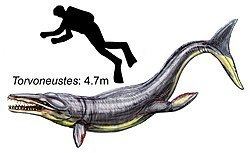Tribe †Geosaurini Rank Genus | Class Reptilia Phylum Chordata | |
 | ||
Similar Tyrannoneustes, Plesiosuchus, Gracilineustes, Cricosaurus, Metriorhynchidae | ||
Torvoneustes is an extinct genus of metriorhynchid mesoeucrocodylian. It is known from a partial skull and some postcranial remains that have been found from the Kimmeridge Clay of Wiltshire, England. The skull was first to be found, and was initially assigned to the species Metriorhynchus superciliosus. Postcranial remains were later discovered, and the material was then recognized as belonging to a new species of Dakosaurus, D. carpenteri. D. carpenteri was later reassigned to the genus Geosaurus in 2008. Two years later, it was assigned to its own genus, Torvoneustes.
When T. carpenteri was considered a species of Dakosaurus, its relatively long snout and smaller, more numerous teeth were thought to be features retained from more basal metriorhynchids. Because of this, the species was seen as a transitional form between long-snouted, piscivorous metriorhynchids and hypercarnivorous, short-snouted species of Dakosaurus.
While Dakosaurus and Geosaurus have ziphodont dentitions with teeth that are laterally compressed, Torvoneustes is unique in having a false-ziphodont dentition. The common ancestor of Dakosaurus and Geosaurus may also have had a ziphodont dentition, and as Torvoneustes is also a descendant of this common ancestor, it is possible that a ziphodont dentition was secondarily lost in the genus. However, it is also possible that Dakosaurus and Geosaurus acquired similar dentitions independently, and that Torvoneustes is not descended from a ziphodont ancestor.
The species was named to honour Simon Carpenter, an amateur geologist from Frome in Somerset, who provided access to the fossil material.
